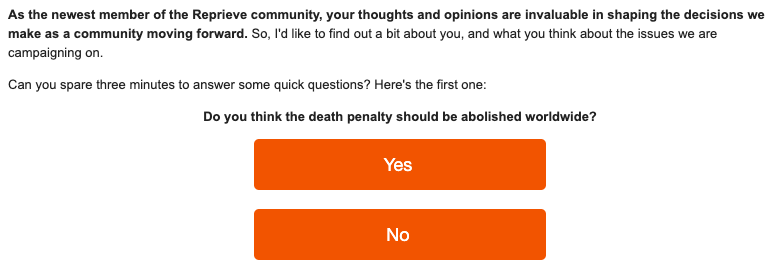Asking your supporters questions makes them feel heard, valued, and part of your charity or movement. But surveys aren’t just great at relationship building – they’re also a powerful tool to drive repeat engagement and encourage higher-bar action taking.
Let’s dive into some tried and tested ways to use surveys effectively for digital mobilisation.
Using surveys in your email welcome series to drive early engagement
Surveys are a great way to kick off a welcome series, as they offer supporters a low-bar action that gets them used to receiving meaningful, action-based emails from your organisation.
In a recent welcome series we did for Tommy’s, almost 60% of new sign-ups took the survey within a day of joining, setting the precedent for repeat engagement along the line.
Thinking about their values and why they’ve chosen to support you, can often pave the way for higher-bar action too (like setting up a regular donation).
When we ended a Reprieve welcome survey with a donation ask it raised 20 times the average income they’d expect from a fundraising email.

For best results, include the first question in the body of the email, high enough so it appears ‘above the fold’ on mobile. We find that making the first question easy, emotive and values-led – with yes/no buttons – makes for a high click to open rate.
It’s always a good idea to follow up with a thank you email that shares some top line results to show you’re listening to what supporters say. You can also use results as a launch pad for another action email based on an issue your audience feels strongly about.
Adding a survey to a petition or sign up page to increase donations
We’ve recently started testing surveys on sign up pages, with the hypothesis that getting a supporter to reflect on why they’ve signed up might increase their motivation to help the campaign go further.
Here’s an example we recently tested with SumOfUs on a variety of petitions.
Asking supporters to reflect on their motivation for signing just prior to a donation ask boosted one-off donations by 27% – 32%.


Once you have some results, you can then investigate how your audience responds to different types of questions. For example, testing whether campaign-specific questions (like the examples above) outperform more general, values-based ones.
Other things you can try
We don’t have data on these yet, so can’t recommend them – but these are a few survey-related tests we’d love to carry out in the future.
Using responses to adapt the user journey
For an email welcome series, we’re keen to test how we can use a supporter’s answers to inform the type of fundraising asks or donate amounts they see at the end of the welcome survey – with the hypothesis that the more tailored the ask, the stronger the conversion rate.
Video surveys
Since people interact with videos so frequently now, we’re excited to see if being asked survey questions via video improves conversion and completion rates, since it feels more personable. If you’re brave enough to try this – let us know!
Are you keen to start using surveys in your user journeys, or have something else you’d like to test? We’d love to hear from you.
